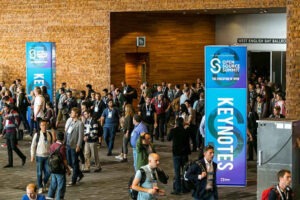When I read that the Takoma Park Maryland Library has 28 workstations running Linux, I literally couldn’t believe it. Really? A library offering the public Linux? Whenever I go to a library, all I ever see are Windows machines or maybe a Mac or two. When I mention Linux as an alternative, and I sometimes do, I’m usually met with blank stares and the staff begins to think I’m nuts.
To check into this, I contacted Phil Shapiro, the library’s Public Geek. Yup. That’s right, he told me. They are running Linux. The decision was made by his supervisor, Rebecca Brown, some time ago.
“This town is quite diverse, with 92 nationalities, so we needed to find a good multilingual solution,” Shapiro explained. “Rebecca chose a Canandian Linux solutions provider, Userful, whose commercial product is built on top of Fedora Linux. Userful does multilingual very well.”

Interestingly, the move to Linux was met with little push back from the patrons using the machines.
“The patrons are quite happy using Linux to get their work done,” Shapiro said. “Very few of them have any clue they’re not using Windows. They surf the web using Firefox and Chrome and use LibreOffice to compose and edit their word processing documents. In the nine years I’ve worked at this library, only one or two people have ever told me, ‘Hey, this isn’t Windows.'”
So much for the learning curve we read so much about — not surprising to those of us who use Linux. Nor are we surprised to hear that running Linux instead of Windows makes things easier on the library’s IT crew.
“We have no virus concerns whatsoever on our computers,” said Shapiro. “People can download whatever files they want that are legal to download. I’d recommend Linux for other public libraries.”
As useful as open source software is to the library, Shapiro thinks it’s the ideas behind open source development and not the software itself that will eventually be the most useful to our libraries.
“I’m interested in open source as a cultural method and philosophy, beyond software creation,” he explained. “To open source the public library means to do more than bring in Linux computers for public use. The heart of the open source method is participation, so a public library that is open sourced has much greater involvement of the public in library decision making, including all uses of library funds.”
It’s no secret that libraries, like many other organizations, are having to adapt to survive in the digital age. The time has passed when a collection of books is enough to keep patrons walking through the door and using a library’s services. As libraries work to redefine their role, Shapiro and like-minded others are seeking to harness ideas of participation and sharing to create an “open source library.”
According to Shapiro, systemically integrating open source ideas into a library’s operations will have the benefit of strengthening the ties between libraries and the communities they serve. “An open sourced library has regular and vigorous discussions about the role of the library in the community,” he said. “With libraries moving beyond books, each community is going to be choosing a slightly different role for its library.”
One idea is the notion of “co-working spaces,” an area of the library that would remain open for long hours, say from six in the morning until midnight, seven days a week, which would require a small monthly fee from users to cover the cost of staffing. In a way, these co-working spaces would be like an expanded version of a “Starbucks office,” without the pressure to spend twenty bucks a day on coffee — or the need to BYOD.
“Co-working spaces are used by people who work for themselves who prefer not to stay at home all day,” explained Shapiro. “In co-working spaces there are often shared tools, such as scanners, color laser printers and the like. There are ripe opportunities for cross-pollination in co-working spaces as people with different talents and competences can rely on each other for help without having to set up formal consulting agreements.”
These work spaces would also find ways to accommodate those who are between jobs or who otherwise can’t afford to pay the monthly fee. “Anyone who is unemployed could have two free months use of the co-working space,” he said. “The most forward-thinking libraries will then find ways that unemployed persons could do work in the space to cover their monthly usage costs — work such as scanning photos, building web sites, editing video, teaching digital competence workshops and so forth.”
These co-working spaces could also become breeding grounds for entrepreneurs who’re just getting started.
“Libraries need to be doing much more to support entrepreneurs,” said Shapiro. “This could happen by helping entrepreneurs create screencasts, launch crowdfunding campaigns, learn basic and advanced features of WordPress, develop skill at using collaborative web services and so on. Naturally, entrepreneurs ought to make a commitment to support the library as their business grows, too. This should not be a moral obligation, but a contractual one, perhaps via the benefit corporation method of making a commitment to support a public purpose as a company grows.”
Phil Shapiro demonstrates Fedora’s multiseat feature.
There are many other ideas on how the open source process can be leveraged by libraries, such as making libraries available during off hours for purposes such as music making, dancing, and community theater — or intellectual contests, an idea which Shapiro wrote about in a PCWorld article back in 2012. Libraries might even find it useful to take a page out of big retail’s playbook and hang-out a sign reading “we never close.”
“It’s not too far-fetched to think that libraries might be open 24/7 some day,” suggests Shapiro. “Where there is a will, there is a way. Communities ought to start having conversations about whether they’d like their library to be open 24/7 — and what is the way to make that happen. In a very competitive knowledge economy, would this boost opportunities for communities to self-advance themselves? I would think, yes.”
Next month Shapiro will be leading a discussion, “Open Sourcing the Public Library,” at the All Things Open (ATO) conference in Raleigh, North Carolina. At the conference, he’ll be touching on all the subjects mentioned here, and more. Of particular interest to me will be his take on the Anythink Libraries in Colorado, which he says “have reached the future several years ahead of everyone else.” The ATO presentation is scheduled to be held on the conference’s second day, October 23, at 3:15 pm.
“I’m hoping that people attending my talk will come to understand that the future of public libraries is filled with possibilities,” Shapiro said, “but that those possibilities won’t materialize until community members step forward to make the possibilities happen. Participation is the key and there is an increasingly important role for the public to take in participating in the operation of their local public libraries.”
Christine Hall has been a journalist since 1971. In 2001, she began writing a weekly consumer computer column and started covering Linux and FOSS in 2002 after making the switch to GNU/Linux. Follow her on Twitter: @BrideOfLinux








Our county library system uses Linux on their servers and the public workstations. They are also using the open source library software “Koha” to run the library system. This was a big improvement over the commercial product they were using before.
http://www.cooslibraries.org/
Open Source Everything
Click on the links in this article, view the future.
@gc I’m just curious to know if the commercial product you replaced with Koha was Millennium or Sierra? (Probably not Sierra as I believe it’s fairly new.)
@Christine
I am not certain what library software they were using before, but I am sure one of the helpful librarians would know. 😉
I am interested in the commercial name for the usb connected device serving as a remote terminal. I researched on Amazon, but did not find the relevant technology.
We have been running Linux on all of our systems at the Beauregard Parish Library (http://library.beau.org) since the 1990’s without many problems. We provide the full *NIX experience, NFS/NIS home directories, email, etc. People like being able to keep bookmarks and other documents between sessions, rearrange the desktop, change wallpapers and basically treat our workstations like it was their own personal machine.
In times past we did have to worry about Crossover Office and before that VMware+Win95 to provide access to Internet Explorer because of the widespread problem of sites that wouldn’t work without it. That is no longer an issue, Firefox + Chrome cover pretty much all important sites now.
We currently run a single unified workstation image across all staff and patron workstations with light per host customization during automated rebuild plus DHCP based customization to cause each group to attach to the right NIS/NFS backend. Multiseat wasn’t mature when we last refreshed the hardware and software so we still use one CPU per seat but will look at it again for the next refresh.
@Michael Salsman
I believe the device in the video is the “Plugable DC-125 USB 2.0 Zero Client”:
http://plugable.com/products/dc-125
Plugable has a newer version called “UD-160-M USB Thin Client”:
http://plugable.com/products/ud-160-m
This company Ncomputing http://www.ncomputing.com/
provides devices which allow the multiseat experience Phil describes in the video on both Windows and Linux.
I have also in the past, used an old PC with multiple video cards plus USB keyboards and mice with a Brazilian distro based on Ubuntu to achieve multiseat computing.
The limitation in the multiseat approach is RAM and video output. The Ncomputing devices fix this issue.
Disclaimer: I have nothing to do with Ncomputing. I mentioned their device to a school IT admin, who pursued the idea and was happily surprised to see their expanded computer lab based on these devices.
Oh, I also want to mention that I think the ‘co-working spaces’ is a wonderful idea. I have sent this link onto my contact within the local government sponsored business incubator.
I am the PI on a grant from the Andrew W. Mellon Foundation to help libraries and other cultural heritage organizations make informed choices about open source software. Two resources from this grant are freely available online. First, the http://FOSS4Lib.org/ website has tools to help organizations “decide /if/ and /which/ open source software is right for them.” Second is an online symposium this week looking at community sustainability from open source project and open source adopter perspectives; details are available at https://foss4lib.org/schoss/open-symposium
I run 11 Xubuntu Linux machines at our local library. All the public machines and 1 librarian one run Xubuntu. They are very easy to maintain and I don’t think 1 in 1000 users even knows it isn’t windows. I have also installed Linux for several patrons who are migrating from XP. Our library software is also open source “Evergreen”. The downside is I can hardly stand to maintain the windows ones as they are slow and require a lot of security and cleanup software.